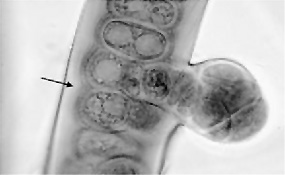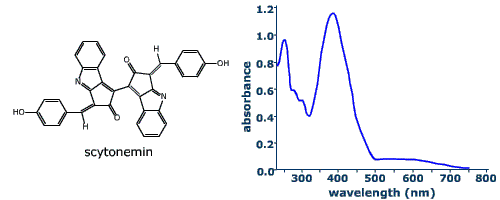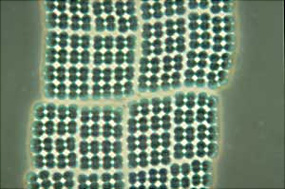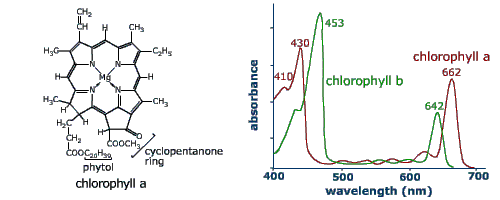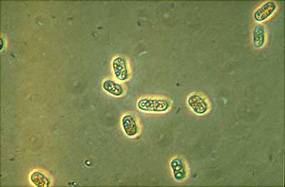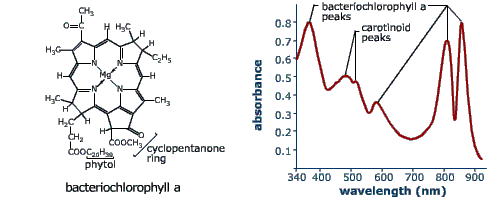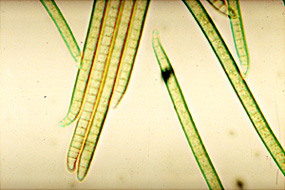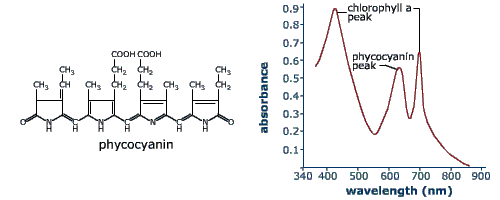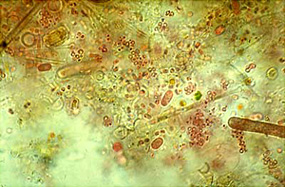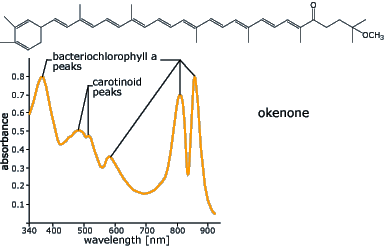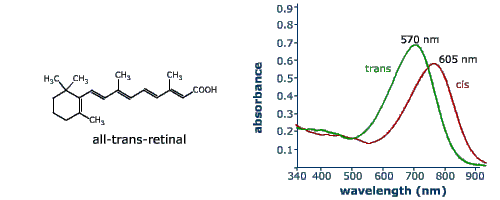|
|
Microorganisms present in high-radiation environments contain pigments which protect them from UV-damage. Scytonemin, one of these pigments, absorbs throughout the solar UV range, including UVC. Screening is most efficient at 370nm (in vivo). (Castenholz 1997) |
|
|
1 - Photomicrograph of a section of branching, filamentous cyanobacterium, Stigonema sp.. Main axis surrounded by a sheath rich in scytonemin (arrow). (Castenholz 1997) |
2 - Scytonemin and screening effectiveness |
|
Chlorophylls Chlorophylls are important pigments involved in photosynthesis, a process that traps light energy and converts it to an electrochemical potential across the cell membrane. This potential can be used to synthesize energy rich organic compounds. (Brock 2003) |
|
3 - Merismopedia sp. containing chlorophylls |
4 - Chlorophyll a molecule and screening effectiveness |
Bacteria contain different bacteriochlorophylls that absorb light in the near infrared. (Brock 2003) | |
|
5 - Chromatium okenii |
6 - Bacteriochlorophyll a molecule and screening effectiveness |
|
Phycocyanin Photosynthetically active organisms try to collect light of the whole visible spectrum. Phycocyanin and other pigments (phycoerythrin and allophycocyanin) are coupled to proteins forming phycobiliproteins, which absorb light between 550 and 650nm. They represent the main light harvesting pigments in cyanobacteria and red algae. (Brock 2003) |
|
7 - Phormidium sp. containing phycocyanin |
8 - Phycocyanin molecule and screening effectiveness |
Okenone Okenone belongs to the most widespread accessory pigments, the carotenoids. These pigments are involved in light energy transfer to the reaction center in photosynthetic organisms. Carotenoids' ability to quench toxic oxygen species such as singlet oxygen (1O2 - generated by light in the presence of oxygen) and thus neutralize these harmful molecules, makes carotenoids' photoprotective nature vital to organisms living in high alpine environments. (Brock 2003) |
|
9 - Chromatiium sp. containing okenone |
10 - Okenone molecule and screening effectiveness |
All-trans retinal Light may even induce conformation changes in molecules. The all-trans retinal of bacteriorhodopsin absorbs light of 570 nm. Bacteriorhodopsin consists of a membrane protein part and the pigment retinal. When exposed to light of 570 nm wavelength, the all-trans form of retinal undergoes a conformational change to its 13-cis form. This change is accompanied with an efflux of protons in Halobacteria sp. which may be used to drive energy-consuming processes inside the cell. (Haacke 2001)
11 - conformational change of the all-trans form retinal |
